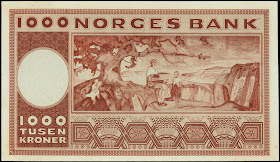Norway 1000 Kroner banknote 1949 Norges Bank
Obverse: Portrait of Henrik Ibsen, playwright and poet whose plays still are being played all over the world.
Reverse: "History", painting by Edvard Munch.
Banknotes of the Norwegian krone
1948-1976 Issue
The 4th issue of Norwegian kroner notes was the first post-war issue that was designed as a long-term issue, the 3rd issue having been prepared during the war for use in a monetary reform situation and was introduced when the 2nd issue was suspended in the autumn of 1945.
The 4th issue consisted of 6 notes, 5, 10, 50, 100, 500 and 1000 kr.
The 4th issue obviously is an attempt to "build the country" after the war. Each note has its own portrait, with famous Norwegians. The reverse is used to visualize one of the important sectors of the Norwegian economy and society.
The 5-kroner is the fisheries note, the 10-kroner is shipping and commerce, 50-kroner farming, 100-kroner forestry, 500-kroner industry and 1000-kroner the arts.
5 Kroner 10 Kroner 50 Kroner 100 Kroner 500 Kroner 1000 Kroner
Henrik Ibsen
Henrik Johan Ibsen (20 March 1828 – 23 May 1906) was a major 19th-century Norwegian playwright, theatre director, and poet. He is often referred to as "the father of realism" and is one of the founders of Modernism in theatre. His major works include Brand, Peer Gynt, An Enemy of the People, Emperor and Galilean, A Doll's House, Hedda Gabler, Ghosts, The Wild Duck, Rosmersholm, and The Master Builder. He is the most frequently performed dramatist in the world after Shakespeare, and A Doll's House became the world's most performed play by the early 20th century.
Ibsen is often ranked as one of the truly great playwrights in the European tradition. Richard Hornby describes him as "a profound poetic dramatist—the best since Shakespeare". He is widely regarded as the most important playwright since Shakespeare. He influenced other playwrights and novelists such as George Bernard Shaw, Oscar Wilde, Arthur Miller, James Joyce, Eugene O'Neill and Miroslav Krleža.
Ibsen wrote his plays in Danish (the common written language of Denmark and Norway) and they were published by the Danish publisher Gyldendal. Although most of his plays are set in Norway - often in places reminiscent of Skien, the port town where he grew up - Ibsen lived for 27 years in Italy and Germany, and rarely visited Norway during his most productive years. Born into a merchant family connected to the patriciate of Skien, his dramas were shaped by his family background. He was the father of Prime Minister Sigurd Ibsen. Ibsen's dramas continue in their influence upon contemporary culture and film with notable film productions including A Doll's House featuring Jane Fonda and A Master Builder featuring Wallace Shawn.
Edvard Munch
Edvard Munch (12 December 1863 – 23 January 1944) was a Norwegian painter and printmaker whose intensely evocative treatment of psychological themes built upon some of the main tenets of late 19th-century Symbolism and greatly influenced German Expressionism in the early 20th century. One of his most well-known works is The Scream of 1893.

